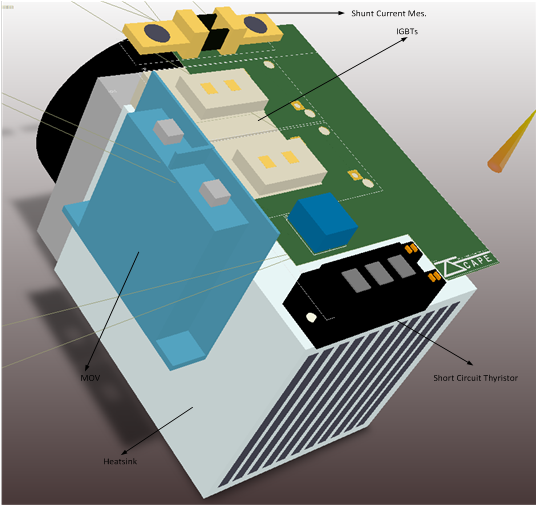Lead Proponent: University of Toronto
Location: Toronto, ON
ecoEII Contribution: $ 560,000
Project Total: $ 1,080,000
Project Background:

3-D representation of the developed technology which is the full-scale DC-CB-1 and highlights the major components of the device. DC-CB1 is an electrical apparatus used to rapidly interrupt electrical current flow to a DC system that is subjected to abnormal conditions for fast protection and/or isolation of utility-grade battery storage systems.
The integration of renewable energy sources into the grid has many important economic and environmental benefits for Canadians, and therefore, electricity generation from these sources has increased dramatically. However, renewable energy sources are typically distributed and variable, putting significant pressure on an electrical grid that was designed decades ago to handle large, dispatchable generators. Moreover, increasing numbers of electric vehicles on distribution networks will put additional stress on the grid. Electrical storage using utility-scale batteries is an important emerging opportunity for managing the challenges imposed on modern distribution grids from variable supply and demands.
One of the key technical barriers to market acceptance and large-scale deployment of utility-scale, grid-connected battery storage systems is the lack of a proven and feasible solution for the protection and rapid isolation of the battery under emergency conditions. Recognizing the technology gap, the University of Toronto proposed the project “DC Arc-Free Circuit Breaker for Utility-Grid Battery Storage System” for ecoEII funding. The University was awarded $560K to develop two novel DC-CB concepts (based on newly developed circuitry) that show promise of providing a commercially viable option.
Results
A Direct-Current (DC) Circuit Breaker (CB) is an electrical apparatus used to rapidly interrupt electrical current flow to a DC system that is subjected to abnormal conditions, such as those resulting from internal component failures or short-circuits. Two DC-CB concepts were developed: DC-CB-1, a bidirectional power electronic switch and DC-CB-2, a fast mechanical switch.
DC-CB-1 utilizes two insulated-gate bipolar transistors and their anti-parallel diodes. During normal operating conditions DC-CB-1 provides a closed electrical path for current to flow to the battery string. However, during an abnormal condition it opens the path and interrupts the current to the batteries. Due to the stray and physical inductances of the converter and the battery string, switching of the DC-CB-1 can result in excessive transient voltages that are neither acceptable to the batteries, to the converter components nor to the switch itself. Thus an Auxiliary Suppression-Circuit (ASC) is introduced to mitigate the switching transients and provide virtually transient-free switching with respect to the battery string and converter. The ASC is a novel and patentable active-circuit configuration. Comprehensive simulation and analysis was carried out to identify the key performance characteristics of DC-CB-1. Then, a scaled-prototype DC-CB-1 (20-Adc/200-Vdc) was designed, developed and used for proof of concept and performance testing. Test results indicated that a field trial ready, full-scale prototype should be developed. This led to a series of activities including component procurement, design verification and modification, development of test cases and procedures, and finally beta site selection. A full-scale DC-CM-1 prototype was successfully developed and ready for installation at a beta site.
DC-CB-2 utilizes a high-speed contactor. During normal operating conditions the mechanical switch is closed and provides an almost perfect path for current flow to the battery string without inducing any losses. However, when an abnormal condition occurs, the mechanical switch opens and interrupts the current flow, typically causing an electrical arc to be formed across the mechanical contacts. The main function of the ASC is to suppress the arc and enable fast and arc-free opening of the DC-CB-2. Comprehensive simulation and analysis was carried out to identify the key performance characteristics of DC-CB-2. Then, a scaled unit of DC-CB-2 was designed, developed and tested. Pre-charge and discharge control strategies and their impact on the arc were tested, and so were the effects of different voltage and current levels, with and without the ASC circuit.
Benefits to Canada
Advancements in DC-CB technology facilitates the proliferation of utility-scale battery storage systems, enabling more renewable generation sources and electric vehicles to be integrated into the electrical grid. This benefits Canada economically and environmentally.
Next Steps
Beta site testing of the full-scale DC-CM-1 prototype, as well as the development and beta site testing of a full-scale DC-CB-2 prototype.